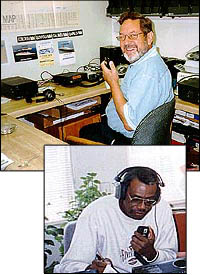
Use the mouse and click on any topic below for more information
Most amateurs simply like to chat on the radio, with friends, family, or strangers. Actually, there are no "strangers" on the amateur bands, since radio hams love to meet and talk to new people! You can chat for hours with someone you've just met. Remember, there are no long-distance charges for amateur radio!
Amateurs who share a common interest frequently gather "on the air" for a roundtable discussion. These are also called radio nets. For example, every week many amateurs from the Georgian Bay area gather to exchange news. (If you have a shortwave receiver, listen at 3.783 MHz, lower sideband, at 9:30 am each Sunday.) There are nets to discuss radio equipment, literature, the Bible, music... and anything else you want to talk about!

This is probably the most common picture of amateur radio, and possibly the most alluring. With a small radio transmitter in your house, and a small antenna outside, you can talk around the world! Europe, Africa, Asia, Australia, North and South America, even Antarctica... all have active radio amateurs who love to chat!
Radio amateurs call this "DXing" or "chasing DX" because "DX" is an old abbreviation for "distance." This is such a popular activity that we have a special call, "CQ", which means "I'd like to talk to any amateur radio station."
(Photo courtesy American Radio Relay League)
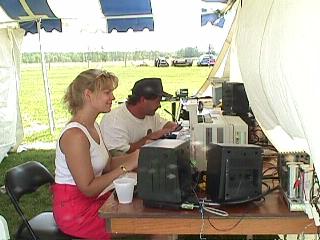
If you have a competitive streak, you might enjoy an amateur radio contest. These usually take place on weekends, and involve making contact with as many different stations, in as many different places, as possible.
Different contests have different goals and restrictions. For example, the objective of the Canada Day contest is to contact as many Canadian stations as possible. In 24 hours, our club contacted 669 Canadian stations and 443 foreign stations!
If you'd like to compete at a more leisurely pace, you can try for one of the many amateur radio operating awards. One example is the DX Century Club certificate, which is awarded to radio amateurs who have made contact with at least 100 different countries.
(Photo by Bill Dowkes VE3DIQ)
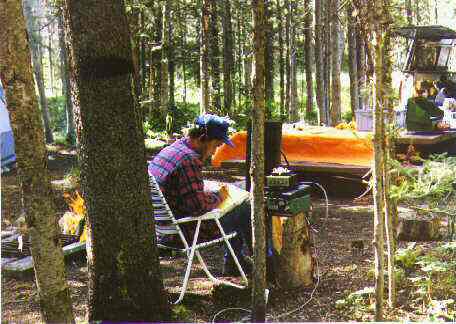
If you commute or travel a lot by auto, you might want to put a ham radio in your car! VHF FM radios are quite small and affordable. As you drive around Canada and the U.S., you'll find that most cities have VHF "repeaters" and ham radio groups. Wherever you go, you'll be welcomed!
You're not limited to your car, and you're not limited to VHF. Radio hams take their equipment bicycling, backpacking, boating, and camping. With a portable shortwave radio and a wire antenna strung between two trees, you can communiate world-wide from your campground!
*Please note, however, that amateur radio is strictly for non-commerical use. You can't put amateur radio transceivers in a fleet of commercial vehicles; you need a commercial radio licence and radios which use commercial frequencies.
(Photo courtesy www.hamradio-online.com)
Amateur radio and computers go together like ham and eggs! Canadians pioneered amateur packet radio, which lets computers communicate with each other by ham radio (using technology very similar to the Internet). There is now a worldwide network of packet radio stations, passing news and private messages automatically from computer to computer to radio amateur.
Mobile amateurs have connected GPS (Global Positioning System) receivers to their computers and radios, and created the APRS (Automatic Position Reporting System) network. APRS stations are tracked automatically as they move, and can send and receive messages "on the go."

With radio amateurs at the forefront of technology, could we resist outer space? For years, we have been building and orbiting our own communications satellites. Satellite radio is becoming very popular, since it doesn't require an expensive radio or elaborate antenna.
Radio amateurs also travel into space. Many astronauts are hams, and the Space Shuttle often carries amateur radio equipment. During one brief communications breakdown, SAREX (the Shuttle Amateur Radio EXperiment) was the Shuttle's only link to earth!
There is even a small, dedicated group of radio amateurs who practice moonbounce -- reflecting radio signals from the moon.
(Photo courtesy American Radio Relay League)
If it can be sent over the airwaves, radio hams have tried it...up to and including television.
There are two kinds of "amateur television." Fast scan television is like the "normal" TV you have at home; this can be transmitted locally on the UHF amateur frequencies. Like the "picturephone" of science fiction, you can see the person you're talking to! (In Ontario, the city of London has many amateur television enthusiasts.)
Slow scan television ("SSTV") is television which has been "slowed down" so that it can be transmitted on the international shortwave frequencies. It takes about eight seconds to send one image, but hams use this every day to send pictures of themselves, their stations, their pets, around the world.
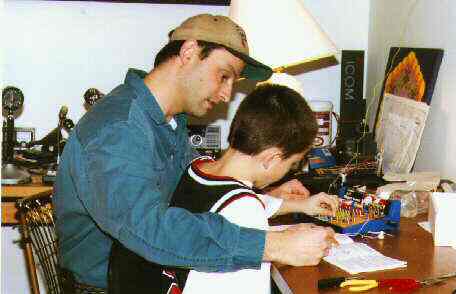
Amateur radio started out as an experimental radio service, and to this day, many hams like to design, build, repair, and experiment with radio equipment. If you are so inclined, you can start with simple projects, like a "homebrew" antenna or a power meter for your station. Several companies make amateur radio kits that are easy and fun to assemble.
If the electronics bug bites, you may choose to restore an old ham radio. Or you may tinker with a newer radio to "soup it up" or add new features. You can go as far as designing and building your own computerized radio transceiver! Radio amateurs publish many books, and even a magazine, QEX, for radio experimenters.
(Photo courtesy www.hamradio-online.com)
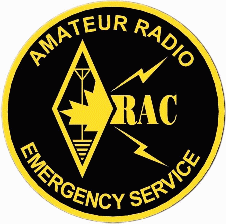

When disaster strikes, radio amateurs are there! During the ice storm in Quebec, when large areas had no power, hams with portable and battery-operated equipment passed health and welfare messages out of the afflicted region. During Hurricane Bonnie, radio hams staffed emergency shelters so that displaced families would have contact with the outside world.
Emergency service is a long and honored tradition within amateur radio. We've formed the Amateur Radio Emergency Service (ARES) to train and coordinate emergency communicators. When the power fails, or the radio towers are toppled, or the telephones are overloaded, we are prepared to step in and provide communications.
(Photo courtesy American Radio Relay League)
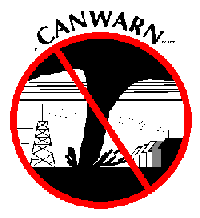
If you've seen the movie "Twister," you know that no radar can take the place of an on-the-spot observer when it comes to spotting tornadoes. That's why Environment Canada has teamed up with amateur radio operators to form CANWARN, the CANadian Weather Amateur Radio Network.
Hundreds of radio amateurs in Ontario have been trained to identify and report dangerous weather conditions. When severe weather approaches, these amateurs go "on the air" and activate the CANWARN network, feeding live weather reports from across the province into the Environment Canada weather tracking office.

Many radio hams like to use their skills, and their equipment, to help their local community. Many ham radio clubs provide volunteer operators for community parades and festivals. And, every Christmastime, radio amateurs across Ontario take their portable radios and form the Santa Claus Net, to let hospitalized and shut-in kids talk to Santa Claus.
Locally, you'll see the Georgian Bay Amateur Radio Club providing radio communications for the Terry Fox Run, the Owen Sound Santa Claus Parade, the Boy Scouts' Jamboree-on-the-Air, and now the Flesherton Split Rail Festival.
(Photo courtesy American Radio Relay League)
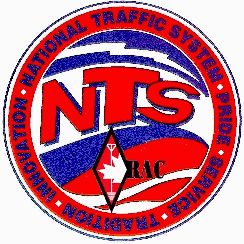
In these days of fax machines, cellular telephones, and the Internet, we take for granted our ability to instantly and inexpensively send a message thousands of miles. But not long ago, "radiograms" were the fastest way to send messages coast-to-coast... and a dedicated group of radio amateurs continues this tradition today.
Why do it? Partly it's a desire to develop a skill -- message handling is amateur radio at its most refined. Partly it's to provide a public service, sending family greetings to distant relatives. Partly it's to prepare for an emergency, when amateur radio is the sole means of communication and "getting the message through" is a must.
And partly, for the same reason hams do anything else -- because it's fun!